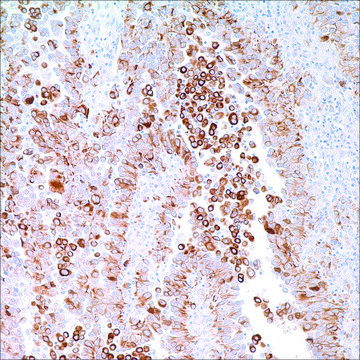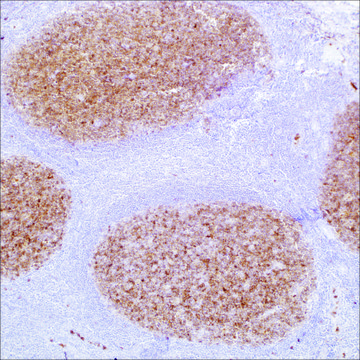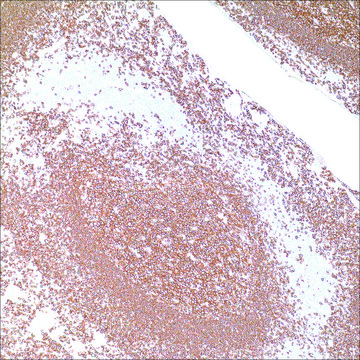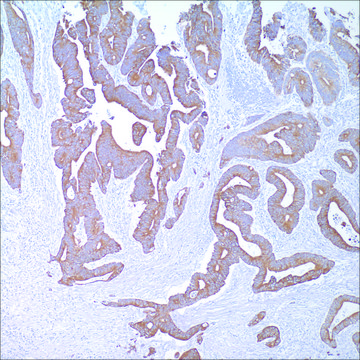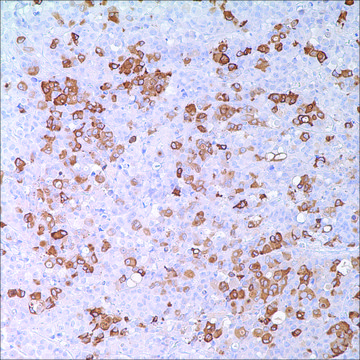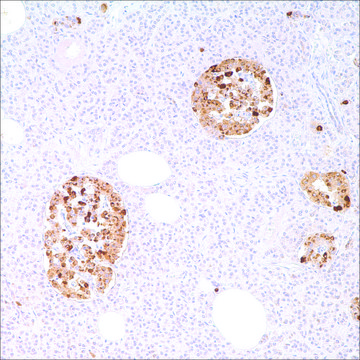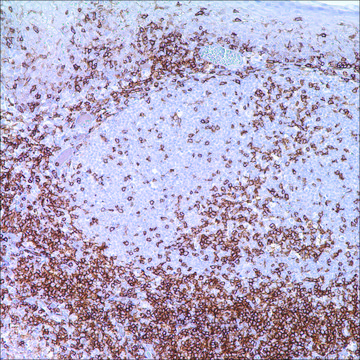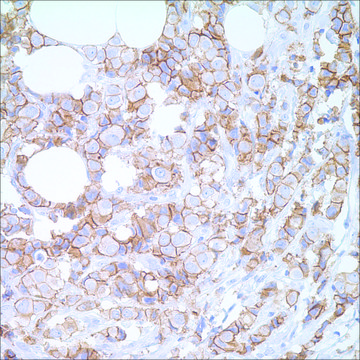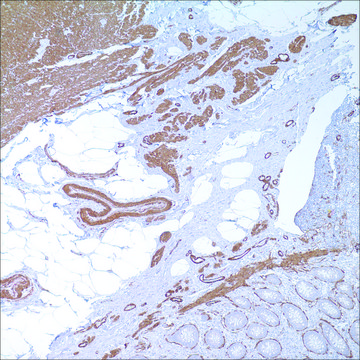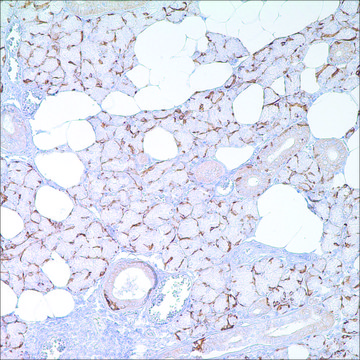推荐产品
生物来源
mouse
质量水平
100
500
偶联物
unconjugated
抗体形式
culture supernatant
抗体产品类型
primary antibodies
克隆
34betaE12, monoclonal
描述
For In Vitro Diagnostic Use in Select Regions (See Chart)
表单
buffered aqueous solution
种属反应性
human
包装
vial of 0.1 mL concentrate (334M-84)
vial of 0.5 mL concentrate (334M-85)
bottle of 1.0 mL predilute (334M-87)
vial of 1.0 mL concentrate (334M-86)
bottle of 7.0 mL predilute (334M-88)
制造商/商品名称
Cell Marque®
技术
immunohistochemistry (formalin-fixed, paraffin-embedded sections): 1:100-1:500
同位素/亚型
IgG1κ
控制
prostate
运输
wet ice
储存温度
2-8°C
可视化
cytoplasmic
基因信息
human ... KRT1(3848)
一般描述
Anti-Cytokeratin, 34betaE12 is an antibody to high molecular weight cytokeratin that reacts with all squamous and ductal epithelium and stains carcinomas. This antibody recognizes cytokeratins 1,5,10, and 14 that are found in complex epithelia. Anti-Cytokeratin, 34betaE12 shows no reactivity with hepatocytes, pancreatic acinar cells, proximal renal tubules, or endometrial glands; there has been no reactivity with cells derived from simple epithelia. Mesenchymal tumors, lymphomas, melanomas, and neural tumors are unreactive with this antibody with some exceptions. Anti-Cytokeratin, 34betaE12 does label myoepithelial cells and has been shown to be useful in distinguishing prostatic adenocarcinoma from hyperplasia of the prostate. This antibody has also been useful in separating benign from malignant intraductal breast proliferations.
质量
 IVD |  IVD |  IVD |  RUO |
联系
Cytokeratin (34betaE12) Positive Control Slides , Product No. 334S, are available for immunohistochemistry (formalin-fixed, paraffin-embedded sections).
外形
Solution in Tris Buffer, pH 7.3-7.7, with 1% BSA and <0.1% Sodium Azide
制备说明
Download the IFU specific to your product lot and formatNote: This requires a keycode which can be found on your packaging or product label.
其他说明
For Technical Service please contact: 800-665-7284 or email: service@cellmarque.com
法律信息
Cell Marque is a registered trademark of Merck KGaA, Darmstadt, Germany
未找到合适的产品?
试试我们的产品选型工具.
法规信息
监管及禁止进口产品
历史批次信息供参考:
分析证书(COA)
Lot/Batch Number
M B Amin et al.
Archives of pathology & laboratory medicine, 118(3), 260-264 (1994-03-01)
Histologic review of 48 radical prostatectomy specimens containing both prostatic adenocarcinoma (PC) and high-grade prostatic intraepithelial neoplasia (PIN) resulted in 23 cases containing neoplastic cribriform gland (CGs) at the periphery or within PC fields. The histologic characteristics of CG PIN
F Moinfar et al.
The American journal of surgical pathology, 23(9), 1048-1058 (1999-09-09)
A variety of studies have investigated the role of low molecular weight (LMW) and high molecular weight (HMW) cytokeratin (CK) expression in the normal breast and invasive breast carcinomas. A few studies with small numbers of cases have addressed this
K J Wojno et al.
The American journal of surgical pathology, 19(3), 251-260 (1995-03-01)
Basal cell-specific anti-cytokeratin antibody (34 beta E12) decorates the basal cells of benign prostatic epithelium by standard immunohistochemical techniques, whereas adenocarcinoma of the prostate lacks immunoreactivity with this antibody. We reviewed our experience with this antibody to determine its utility
X J Yang et al.
The American journal of surgical pathology, 23(2), 147-152 (1999-02-16)
Immunohistochemistry with antibodies for high-molecular-weight cytokeratin labels basal cells and is used as an ancillary study in diagnosing prostate carcinoma, which reportedly lacks expression of high-molecular-weight cytokeratin. A recent report questioned the specificity of this marker, describing immunopositivity for high-molecular-weight
F P O'Malley et al.
Virchows Archiv. A, Pathological anatomy and histopathology, 417(3), 191-196 (1990-01-01)
There are a number of benign, small-acinar lesions in the prostate gland that may be difficult to differentiate from small-acinar adenocarcinoma. An important diagnostic criterion in this differentiation is the loss of the basal layer in small-acinar adenocarcinoma and its
我们的科学家团队拥有各种研究领域经验,包括生命科学、材料科学、化学合成、色谱、分析及许多其他领域.
联系技术服务部门